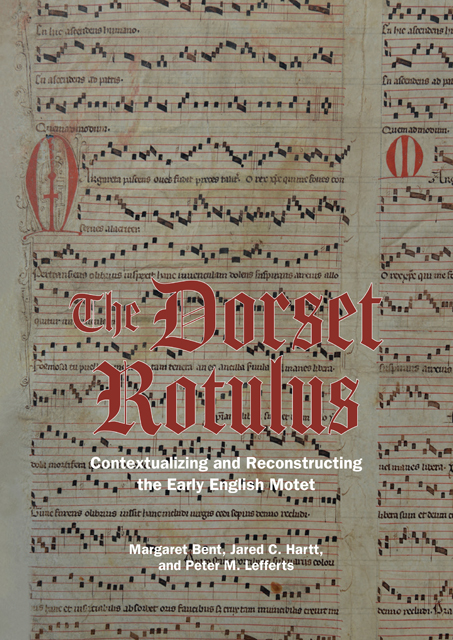Book contents
- Frontmatter
- Contents
- List of Figures
- List of Music Examples
- List of Tables
- Abbreviations
- Note on the Transcriptions
- Introduction
- 1 The Source and its Contents
- 2 Contexts and Designs
- 3 Voice-Exchange Motets and Ascendenti sonet geminacio/ Viri Galilei
- 4 Margareta pascens oves and its Large-Scale Comparands
- 5 Rota versatilis: Towards a Reconstruction
- 6 The Curious Case of Regina preminencie/ Gemma nitens/ … mater es intacta
- 7 Introducing Naufragantes visita/ Navigatrix inclita/ T. Aptatur/ … velox perpetrat
- 8 The Musical Rotulus: Artifact, Image, and Attributes
- 9 Epilogue: Conclusions and Speculation
- Appendix: Transcriptions, Texts, and Translations of the Four Dorset Motets
- Bibliography
- Index of Manuscripts
- Index of Musical Compositions
- General Index
- Studies in Medieval and Renaissance Music
1 - The Source and its Contents
Published online by Cambridge University Press: 14 January 2023
- Frontmatter
- Contents
- List of Figures
- List of Music Examples
- List of Tables
- Abbreviations
- Note on the Transcriptions
- Introduction
- 1 The Source and its Contents
- 2 Contexts and Designs
- 3 Voice-Exchange Motets and Ascendenti sonet geminacio/ Viri Galilei
- 4 Margareta pascens oves and its Large-Scale Comparands
- 5 Rota versatilis: Towards a Reconstruction
- 6 The Curious Case of Regina preminencie/ Gemma nitens/ … mater es intacta
- 7 Introducing Naufragantes visita/ Navigatrix inclita/ T. Aptatur/ … velox perpetrat
- 8 The Musical Rotulus: Artifact, Image, and Attributes
- 9 Epilogue: Conclusions and Speculation
- Appendix: Transcriptions, Texts, and Translations of the Four Dorset Motets
- Bibliography
- Index of Manuscripts
- Index of Musical Compositions
- General Index
- Studies in Medieval and Renaissance Music
Summary
The two fragments Dor a and b (10959a and 10959b) stood at the beginning of an imposing musical rotulus which contained four or more large-scale motets, composed and copied in England in the first quarter of the fourteenth century. As happened to most musical manuscripts of the period when their contents became obsolete, this rotulus was dismantled and the parchment recycled: in the case of these two fragments, as binding material for administrative documents. The extant motets are:
a–b recto
1 Ascendenti sonet geminacio/ Viri Galilei/ [Tenor I]/ [Tenor II]
2 Margareta pascens oves/ [Tenor I]/ [Tenor II]
a–b verso
3 Regina preminencie/ Gemma nitens/ … mater es intacta
4 Naufragantes visita/ Navigatrix inclita/ T. Aptatur/ … velox perpetrat
The first composition listed, hereafter Ascendenti/Viri, along with the second and fourth, Margareta and Naufragantes/Navigatrix, are four-voice motets; Regina/Gemma is a three-voice motet. The first two are monotextual, the last two polytextual.
On both sides of the rotulus, the motet on fragment a continues on b with a loss of two staves between the fragments; see Figures 1.1–1.4. Both fragments have been cut off vertically, losing about half of the second column of each recto (and consequently of the first column of each verso), and there is further damage, especially at the bottom of a, whose upper and lower edges are now ragged, apparently from rodent damage. The top and bottom of leaf b have been trimmed off almost horizontally. Both were surely more regularly shaped and similar in size when used to cover now-lost documents. Fragment a has a substantial top margin, and both fragments retain a small portion of left-hand margin on rectos, right-hand margin on versos.
Ink color is consistent, and the close coordination of ruling and text–music placement attest the work of a single scribe. Andrew Wathey points out inconsistencies with the text hand, such as in the formation of descenders, which led him to judge the script as of moderate quality, but it is neat and accurate. The music is exceptionally carefully and handsomely notated; the appearance of the whole is entirely professional.
- Type
- Chapter
- Information
- The Dorset RotulusContextualizing and Reconstructing the Early English Motet, pp. 5 - 26Publisher: Boydell & BrewerPrint publication year: 2021



